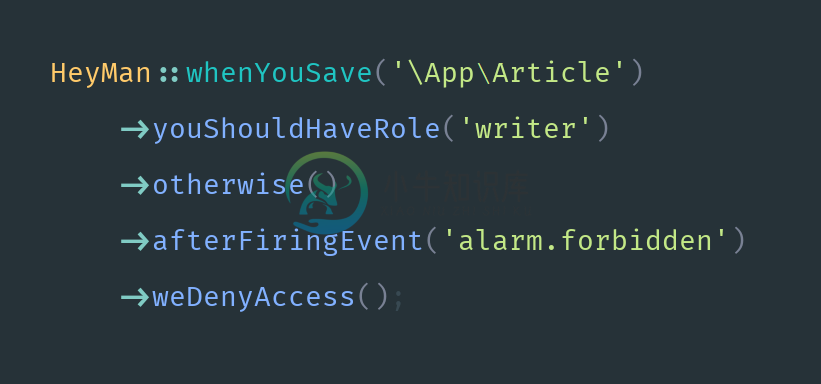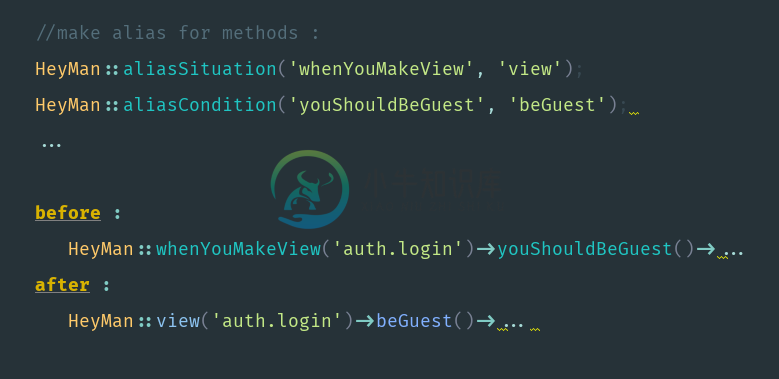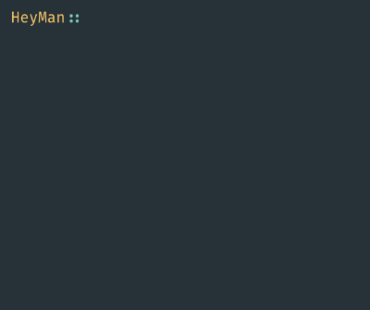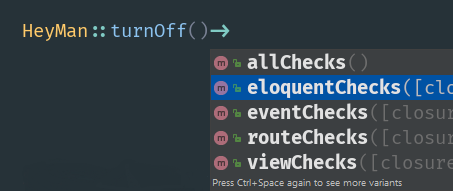Laravel Hey Man
Readability Counts. In fact, Readability is the primary value of your code !!!
��
Heyman continues where the other role-permission packages left off...
We have used CDD (Creativity Driven Development) alongside the TDD
Built with
❤️
for every smart laravel developer
Very well tested, optimized and production ready!
In fact, We have tackled a lot of complexity behind the scenes, to provide you with a lot of simplicity.
- Integrated with laravel-debugbar package out of the box: laravel debugbar
Installation:
composer require imanghafoori/laravel-heyman
Requirements:
- PHP v7.0 or above
- Laravel v5.1 or above
Example:
Here you can see a good example at:
https://github.com/imanghafoori1/council
Specially this file:
https://github.com/imanghafoori1/council/blob/master/app/Providers/AuthServiceProvider.php
This is fork from result of laracasts.com tutorial series refactored to use the Heyman package.
Heyman, let's fight off zombies
Zombie Http Request =>
<= Laravel Heyman
A story:
Imagine your boss comes to you and says :
Hey man !!!
When you visit the login form,
You should be guest,
Otherwise you get redirected to '/panel',
Write the code for me, just now... But KEEP IN MIND you are not allowed to touch the current code. it is very sensitive and we do not want you to tamper with it. You may break it.
And you write code like this in a Service Provider boot method to implement what your boss wanted.
That is what this package does for you + a lot more...
Customizable Syntax:
You can alias methods like this if you do not like too much verbose syntax provided by default.
- Alias Situations (ex.
whenYouMakeViewtoview) - Alias Conditions (ex.
youShouldBeGuesttobeGuest)
You should do it in the boot method.
Structural Benefits:
1- This way you can fully decouple authorization and a lot of guarding code from the rest of your application code and put it in an other place. So your Controllers and Routes become less crowded and you will have a central place where you limit the access of users to your application or perform Request validation.
2- In fact, when you write your code in the way, you are conforming to the famous "Tell don't ask principle."
You are telling the framework what to do in certain situations rather than getting information and decide what to do then.
Procedural code gets information then makes decisions. Object-oriented code tells objects to do things. — Alec Sharp
3- This approach is paticularly useful when you for example write a package which needs ACL but you want to allow your package users to override and apply they own ACL (or validation) rules into your package routes...
And that becomes possible when you use laravel-HeyMan for ACL. The users can easily cancel out the default rules and re-write their favorite acl or validation stuff in a regular ServiceProviders.
Hey Man, that is Amazing stuff!
// This is written in package and lives in vendor folder, So we can not touch it.
HeyMan::whenYouHitRouteName('myPackageRoute')->youShouldHaveRole(....;
To override that we use the forget method, within app/Providers/... :
public function boot() {
// Cancels out the current rules
HeyMan::forget()->aboutRoute('myPackageRoute');
// Add new rules by package user.
HeyMan::whenYouHitRouteName('myPackageRoute')-> ...
}
Hey Man, Should I Momorize all the Methods?!
You do not need any cheat sheet.
IDE
Auto-completionis fully supported.
Hey Man, Where do I put these Heyman:: calls?
You may put them in
AuthServiceProvider.php(or any other service provider)bootmethod.
Usage:
You should call the following method of the HeyMan Facade class.
use Imanghafoori\HeyMan\Facades\HeyMan;
// or
use HeyMan; // <--- alias
Again we recommend visiting this file:
Situations:
HeyMan:: (situation) -> (condition) -> otherwise() -> (reaction) ;
1- Url is matched
HeyMan::whenYouVisitUrl(['/welcome', '/home'])->... // you can pass an Array
HeyMan::whenYouVisitUrl('/admin/*')->... // or match by wildcard
HeyMan::whenYouSendPost('/article/store')-> ...
HeyMan::whenYouSendPatch('/article/edit')-> ...
HeyMan::whenYouSendPut('/article/edit')-> ...
HeyMan::whenYouSendDelete('/article/delete')-> ...
2- Route Name is matched
HeyMan::whenYouHitRouteName('welcome.name')->... // For route names
HeyMan::whenYouHitRouteName('welcome.*')->... // or match by wildcard
3- Controller Action is about to Call
HeyMan::whenYouCallAction('HomeController@index')->...
HeyMan::whenYouCallAction('HomeController@*')->... // or match by wildcard
4- A View file is about to render
HeyMan::whenYouMakeView('article.editForm')->... // also accepts an array
HeyMan::whenYouMakeView('article.*')->... // You can watch a group of views
Actually it refers to the moment when view('article.editForm') is executed.
5- Custom Event is Fired
HeyMan::whenEventHappens('myEvent')->...
Actually it refers to the moment when event('myEvent') is executed.
6- An Eloquent Model is about to save
HeyMan::whenYouSave(\App\User::class)->...
HeyMan::whenYouFetch(\App\User::class)->...
HeyMan::whenYouCreate(\App\User::class)->...
HeyMan::whenYouUpdate(\App\User::class)->...
HeyMan::whenYouDelete(\App\User::class)->...
Actually it refers to the moment when eloquent fires it's internal events like: (saving, deleting, creating, ...)
Note that the saving model is passed to the Gate of callback in the next chain call. so for example you can check the ID of the model which is saving.
Conditions:
HeyMan:: (situation) -> (condition) -> otherwise() -> (reaction) ;
After mentioning the situation, it is time to mention the condition.
1- Gates:
// define Gate
Gate::define('hasRole', function(){...});
Then you can use the gate:
HeyMan::whenYouVisitUrl('/home')->thisGateShouldAllow('hasRole', 'editor')->otherwise()->...;
Passing a Closure as a Gate:
$gate = function($user, $role) {
/// some logic
return true;
}
HeyMan::whenYouVisitUrl('/home')->thisGateShouldAllow($gate, 'editor')->otherwise()->...;
2- Authentication stuff:
HeyMan::whenYouVisitUrl('/home')-> youShouldBeGuest() ->otherwise()->...;
HeyMan::whenYouVisitUrl('/home')-> youShouldBeLoggedIn() ->otherwise()->...;
3- Checking A Closure or Method or Value:
HeyMan::whenYouVisitUrl('home')->thisMethodShouldAllow('someClass@someMethod', ['param1'])->otherwise()->...;
HeyMan::whenYouVisitUrl('home')->thisClosureShouldAllow( function($a) { ... }, ['param1'] ) ->otherwise()->...;
HeyMan::whenYouVisitUrl('home')->thisValueShouldAllow( $someValue )->otherwise()->...;
4- Validate Requests:
HeyMan::whenYouHitRouteName('articles.store')->yourRequestShouldBeValid([
'title' => 'required', 'body' => 'required',
]);
You can also modify the data before validation by calling beforeValidationModifyData().
$modifier = function ($data) {
// removes "@" character from the "name" before validation.
$data['name'] = str_replace('@', '', $data['name']);
return $data;
}
HeyMan::whenYouHitRouteName('welcome.name')
->yourRequestShouldBeValid(['name' => 'required'])
->beforeValidationModifyData($modifier);
5- Check points:
You can also declare some check points some where, within your application code:
HeyMan::checkPoint('MyLane');
And put some rules for it
HeyMan::whenYouReachCheckPoint('MyLane')->youShouldHaveRole('Zombie')-> ...
HeyMan::whenYouVisitUrl('home')->always()-> ...
HeyMan::whenYouVisitUrl('home')->sessionShouldHave('key1')->...
Other things:
You can also use "always" and "sessionShouldHave" methods:
HeyMan::whenYouVisitUrl('home')->always()-> ...
HeyMan::whenYouVisitUrl('home')->sessionShouldHave('key1')->...
Define your own conditions:
You can extend the conditions and introduce new methods into heyman API like this:
// Place this code:
// In the `boot` method of your service providers
HeyMan::condition('youShouldBeMan', function () {
return function () {
return auth()->user() && auth()->user()->gender === 'Man';
};
});
// or
HeyMan::condition('youShouldBeMan', '\App\SomeWhere\SomeClass@someMethod');
Then you can use it like this:
HeyMan::whenYouVisitUrl('home')->youShouldBeMan()-> ...
Nice, isn't it ?!
Reactions:
HeyMan:: (situation) -> (condition) -> otherwise() -> (reaction) ;
1- Deny Access:
HeyMan::whenSaving(\App\User::class)->thisGateShouldAllow('hasRole', 'editor')->otherwise()->weDenyAccess();
An AuthorizationException will be thrown if needed
2- Redirect:
HeyMan::whenYouVisitUrl('/login')-> ... ->otherwise()->redirect()->to(...) ->with([...]);
HeyMan::whenYouVisitUrl('/login')-> ... ->otherwise()->redirect()->route(...) ->withErrors(...);
HeyMan::whenYouVisitUrl('/login')-> ... ->otherwise()->redirect()->action(...) ->withInput(...);
HeyMan::whenYouVisitUrl('/login')-> ... ->otherwise()->redirect()->intended(...);
HeyMan::whenYouVisitUrl('/login')-> ... ->otherwise()->redirect()->guest(...);
In fact the redirect method here is very much like the laravel's redirect() helper function.
3- Throw Exception:
$msg = 'My Message';
HeyMan::whenYouVisitUrl('/login')
->youShouldBeGuest()
->otherwise()
->weThrowNew(AuthorizationException::class, $msg);
4- Abort:
HeyMan::whenYouVisitUrl('/login')-> ... ->otherwise()->abort(...);
5- Send Response:
Calling these functions generate exact same response as calling them on the response() helper function:return response()->json(...);
HeyMan::whenYouVisitUrl('/login')-> ... ->otherwise()->response()->json(...);
HeyMan::whenYouVisitUrl('/login')-> ... ->otherwise()->response()->view(...);
HeyMan::whenYouVisitUrl('/login')-> ... ->otherwise()->response()->jsonp(...);
HeyMan::whenYouVisitUrl('/login')-> ... ->otherwise()->response()->make(...);
HeyMan::whenYouVisitUrl('/login')-> ... ->otherwise()->response()->download(...);
6- Send custom response:
HeyMan::whenYouVisitUrl('/login')->
...
->otherwise()
->weRespondFrom('\App\Http\Responses\Authentication@guestsOnly');
namespace App\Http\Responses;
class Authentication
{
public function guestsOnly()
{
if (request()->expectsJson()) {
return response()->json(['error' => 'Unauthenticated.'], 401);
}
return redirect()->guest(route('login'));
}
}
Hey man, You see ? we have just an Http response here. So our controllers are free to handle the right situaltions and do not worry about exceptional ones.
More Advanced Reactions:
Hey man, You may want to call some method or fire an event right before you send the response back.You can do so by afterCalling() and afterFiringEvent() methods.
HeyMan::whenYouVisitUrl('/login')-> ... ->otherwise()->afterFiringEvent('explode')->response()->json(...);
HeyMan::whenYouVisitUrl('/login')-> ... ->otherwise()->afterCalling('someclass@method1')->response()->json(...);
Disabling Heyman:
You can disable HeyMan checks like this (useful while testing):
HeyMan::turnOff()->eloquentChecks();
...
/// You may save some eloquent models here...
/// without limitations from HeyMan rules.
...
HeyMan::turnOn()->eloquentChecks();
��
Contributing:
If you find an issue, or have a better way to do something, feel free to open an issue or a pull request.
⭐
Your Stars Make Us Do More
⭐
As always if you found this package useful and you want to encourage us to maintain and work on it. Just press the star button to declare your willing.
More from the author:
Laravel Widgetize
Laravel Terminator
Laravel AnyPass
Laravel Microscope
Great spirits have always encountered violent opposition from mediocre minds.
"Albert Einstein"
-
Laravel 是一套简洁、优雅的PHP Web开发框架(PHP Web Framework)。它可以让你从面条一样杂乱的代码中解脱出来;它可以帮你构建一个完美的网络APP,而且每行代码都可以简洁、富于表达力。 功能特点 1、语法更富有表现力 你知道下面这行代码里 “true” 代表什么意思么? $uri = Uri::create(‘some/uri’, array(), array(), tr
-
我需要空间/Laravel权限的帮助。当我试图分配它给我错误哎呀,看起来像出了问题。 错误 Connection.php第761行中的QueryExcema:SQLSTATE[23000]:完整性约束冲突:1048列role_id不能为空(SQL:插入到(,)值(9,))
-
Laravel 作为现在最流行的 PHP 框架,其中的知识较多,所以单独拿出来写一篇。 简述 Laravel 的生命周期 Laravel 采用了单一入口模式,应用的所有请求入口都是 public/index.php 文件。 注册类文件自动加载器 : Laravel通过 composer 进行依赖管理,无需开发者手动导入各种类文件,而由自动加载器自行导入。 创建服务容器:从 bootstrap/ap
-
简介 Laravel Scout 为 Eloquent 模型 全文搜索提供了简单的,基于驱动的解决方案。通过使用模型观察者,Scout 会自动同步 Eloquent 记录的搜索索引。 目前,Scout 自带一个 Algolia 驱动;不过,编写自定义驱动很简单, 你可以轻松的通过自己的搜索实现来扩展 Scout。 安装 首先,通过 Composer 包管理器来安装 Scout: composer
-
简介 Laravel 致力于让整个 PHP 开发体验变得愉快, 包括你的本地开发环境。 Vagrant 提供了一种简单,优雅的方式来管理和配置虚拟机。 Laravel Homestead 是一个官方预封装的 Vagrant box,它为你提供了一个完美的开发环境,而无需在本地机器安装 PHP 、Web 服务器和其他服务器软件。不用担心会搞乱你的操作系统!Vagrant boxes 是一次性的。如果
-
WebStack-Laravel 一个开源的网址导航网站项目,具备完整的前后台,您可以拿来制作自己的网址导航。 部署 克隆代码: git clone https://github.com/hui-ho/WebStack-Laravel.git 安装依赖: composer installphp artisan key:generate 编辑配置: cp .env.example .env ...D









